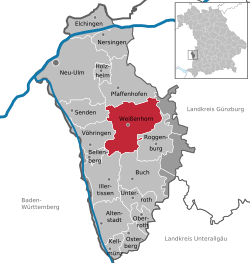Weißenhorn
| Weißenhorn | ||
|---|---|---|
|
||
| Coordinates: 48°18′N 10°10′E / 48.300°N 10.167°ECoordinates: 48°18′N 10°10′E / 48.300°N 10.167°E | ||
| Country | Germany | |
| State | Bavaria | |
| Admin. region | Schwaben | |
| District | Neu-Ulm | |
| Government | ||
| • Mayor | Dr. Wolfgang Fendt (Ind.) | |
| Area | ||
| • Total | 53.69 km2 (20.73 sq mi) | |
| Elevation | 501 m (1,644 ft) | |
| Population (2015-12-31) | ||
| • Total | 13,329 | |
| • Density | 250/km2 (640/sq mi) | |
| Time zone | CET/CEST (UTC+1/+2) | |
| Postal codes | 89264 | |
| Dialling codes | 07309, 07306 (Emershofen) | |
| Vehicle registration | NU | |
| Website | www.weissenhorn.de | |
Weißenhorn is a town in the district of Neu-Ulm in Bavaria. Weißenhorn is located about 22 km southeast of Ulm.
Archaeologic finds prove that the area of Weißenhorn was once a settlement of the Alamanni. Also Roman artifacts and artifacts from the Stone Age have been found.
Weißenhorn was first mentioned in 1160 as villa Wizzenhorn. Starting from the thirteenth century Weißenhorn was seat of a line from the aristocratic house of the Neuffen. When it expired in 1342, Weißenhorn came into possession of the dukes of Bavaria, which had pawned Weißenhorn during the most time. 1473 Louis IX of Bavaria held court in Weißenhorn. During the Landshut War of Succession Weißenhorn came into possession of Holy Roman Emperor Maximilian I and became a provincial city of Further Austria. Maximilian transferred the possession to Jacob Fugger in 1507, due to Weißenhorns delivered and reconfirmed privileges the sovereignty rights however remained with Austria. The Fugger family, which held rule over centuries, promoted the local barchent weaving mill and made Weißenhorn into a flourishing commercial town. Besides Augsburg Weißenhorn is the only town which is officially allowed to carry the title of "Fuggerstadt" (Fugger town).
In the German Peasants' War the town was attacked at 1 April 1525 by 12,000 farmers, led by their Captain Jörg von Ingstetten ("Bauern-Jörgl"), which spared the town after successful defense of the citizen and attacked the neighbouring Roggenburg Abbey.
The known bandit and murderer Matthias Klostermayr alias "The Bavarian Hiasl", who was up to mischief in the 18th century, was nearly imprisoned by the police of Roggenburg.
...
Wikipedia



